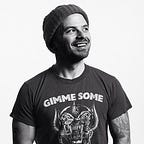Modernism and Sports Design
American football is a great example of how we managed to transform a primal activity to tidily distributed (and somewhat delusional) form of entertainment.
It’s this transformation that can render some insights on modern–day branding, sport and violence. This narrative is not innocent of modernist values and post-war design. These ideas are integrated in commercial context, corporations and media.
Branding
With the growth of professional graphic design, artists started creating identity systems for sports teams with the same rigor previously only reserved for commercial business and large corporations.
If before these tasks were relegated to uniform shops or “artists” with personal affiliation, a new aesthetic started to mature. One that is far more elaborate than the previous local casual folk art direction, and closer to corporate brand exercise.
The Rams
The Rams returned to Los Angeles for 2016 and were playing at the Los Angeles Coliseum — an amazingly vintage setting for such large market NFL team.
Attendance: 134,254 (all-time record)
Built in 1923, it is a beautiful example of modern fabrication techniques, refined through world wars still align with American values. Parkinson & Parkinson heritage is clearly demo’ing how mass structures can still embody good old American values.
The coliseum itself is grandiose in scale and seating arrangement. It might as well have been in direct vicinity to the Roman Forum—which is somewhat fitting, given that it housed the 1932 Olympics. Its details and finishes bridge classic architecture, and an Art Deco approach.
The Rams started off in Cleveland. When they moved to L.A., expanding the influence of the NFL across the nation for the first time ever, their identity was largely unchanged.
This was the case until 1947, when a University of an art–graduate–turned–professional–football–player by the name of Fred Gehrke decided he had enough with the dull Rams helmets, and presented an idea to the owners.
He took a brown leather helmet home, painted it blue, and then added the yellow horns. This design decision became the first decorated helmet design in the NFL, and Bob Snyder, the Rams’ owner, had him paint all the helmets in the offseason.
Gehrke painted helmets for 2 years afterwards until post-war ingenuity combined with the newly popular plastic fabrication paved the way for plastic helmets. It was shortly after that the entire league adapted much more prominent helmet branding.
It was this early development that started the trajectory of modern designs in sporting gear, and branding.
Clear, bold design felt new and in a time of widespread cultural and marketplace innovation it signaled a new direction in how sports was represented. It now meant that sports was a part of the wider culture and could enjoy the bold graphics other sectors did.
Its no coincidence that this all occurred around a time when professional sports gained economic success, leading to the media behemoths we all know today.
In its infancy it created what some (including myself) would consider The Golden Era of Sports Design. The timelessness, honesty and soul the sport had back then is mostly due to the fact the entire industry was produced by hand. It was fresh, clean, concise, simple but felt human—and not overtly industrialized and sterile.
Below are some examples of this era:
More recently, there have been more teams looking to some of these classic modern approaches to sports identity.
Whether out of a pastiche, or a yearning for a more transparent brand designs are now making clearer references to that era – trying to position themselves closer the good old days.
Interestingly the handmade, rather naive Rams logo remained until the 80’s when the Rams made yet another decision — making the iconic helmet itself the logo. This was the case during their move to St. Louis, and up to the point when the Ram was developed.
The new rendering style defines a very particular look that sports adapted in the 90's/early 2000’s.
It is only recently this look has lost its popularity, in favor of a more nostalgic reference to earlier, more soulful days.
There are some parallels between that arc, and challenges that Modernism dealt with as a whole. Especially when considering the myopic vision of a large majority of this being the work of white European and American males. This wasn’t the collective aesthetic that could better organize humanity in a truly universal sense (an impossible task). Any notion to that end really just meant a imperialistic singular viewpoint — not necessarily a malicious one, but still singular nonetheless.
Can we all follow and construct a prescriptive idea of “modern” given the breadth and scope of human experiences and cultural identities?
Can we truly control an unruly and violent physical activity that only succeeded through primal activities contained in helmets and protective padding?
The short answer to both is: not really. But that basic human reality shouldn’t get in the way of optimism, progress and a celebration of our primal selves.
Side note: there are great people who devote their time to documenting the history sports logos/uniforms like Paul Lukas, Todd Radom and Chris Creamer. I am no true historian. I am however a Wisconsin-born Green Bay Packers fan that practices as a Creative Director and Designer.
